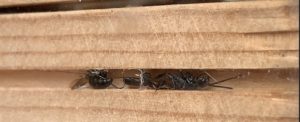Gasteruption jaculator and the hylaeus bee battle inside a nurturing nature nest box
Since having common yellow face bees (Hylaues communis) nesting in my nest boxes, the alien-looking Gasteruption jaculator is a regular visitor with numbers increasing as the common yellow face bee numbers increase. Prior to having the bees nest, I cannot ever recall seeing them these wasps.

Gasteruption jaculator and hylaeus bee battle!
A cleptoparasitic wasp that has a most awkward looking long, white-tipped ovipositor trailing behind it. Its long slender thin body and long ovipositor make it an ideal shape to squeeze into long thin channels as used by cavity nesters. Unlike Ichneumon wasps species from my observations, this extremely flexible needle-like ovipositor is not used for drilling through hard substrates, like wood or mud, e.g. Ephialtes manifesto, but for probing for weaknesses inside a hosts nest cell and then to lay its egg. It’s simply is too flexible to drill into a hard surface. The wasp larva hatches and consumes the host egg or larva alive as well as the forage stored for the bee egg. Parlow et al state that this family of wasps will do exactly the same to some wasp species, whereby their larva consume the paralysed prey items stored for the larva wasp host, i.e. this wasp larva also eats other wasp larva and their prey provisions. Gruesome! Some species of parasitoid wasps use vibrational soundings, including G jaculator, a form of echolocation to find their hosts.
Why did she enter with the bee present?
I suspect the wasp had already found the location of the host eggs and provisions by using her antennae to detect olfactory cues (smells) from the hosts, as I have watched many times now. It’s like vibrating and drumming along the cell floors outside or inside a suspect host cavity. They are also equipped with fat in their hind legs which amazingly may function to amplify vibrations used to detect movement of concealed hosts. Assuming the G. jaculator wasp in the film performed both of the above, how did she not detect the female bee inside her nest cavity, in front of her eggs/larvae and provisions? Or was it detected but she thought she would try to oviposit anyways? Who knows what she was thinking. Her ovipositor may well have been damaged after being clamped upon by the mandibles of the bee. At first, I thought the bee was a Hylaeus communis but as she left the nest I saw the yellow markings behind her head on the top of her thorax, like ‘epaulettes’ similar to H. hyalinatus. just as the G. jaculator escapes from her grip.
There is a whole lot more to come about these wasps.
Else and Edwards (2018) “Handbook of the Bees of the British Isles”, The Ray Society, c/o The Natural History Museum, Cromwell Road London SW7 5BD
Steven Falk’s Field Guide to the Bees of Great Britain and Ireland is a must-have book if you want to ID bees and this extremely useful resource Steven Falk’s Flickr website which furnishes extra photos and other useful resources to assist with identification.
Solitary Bees by Ted Benton I highly recommend

Superb videography of a rare moment in a wee bee’s life, shots that could not have been had without your observation nests. Bad day for a wasp, the price for having to back in, exposing one’s arse to an angry resident!
Yes, to be nipped like that Jim, for over 20 mins just must have hurt! Cheers George